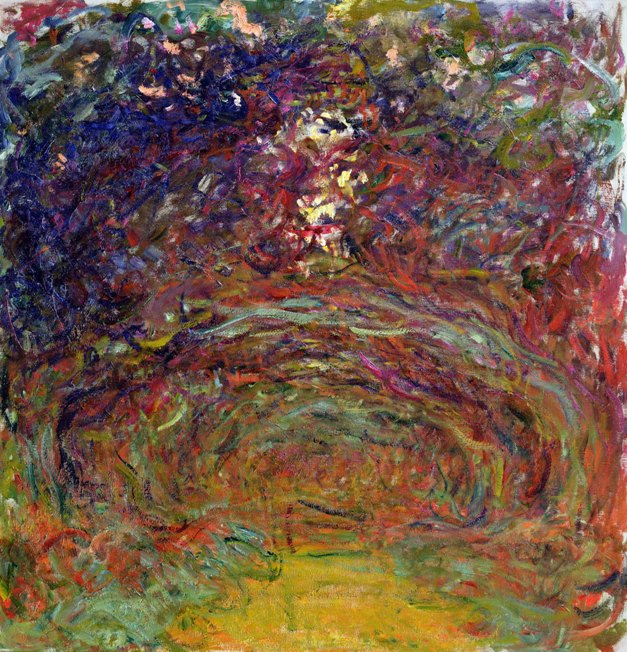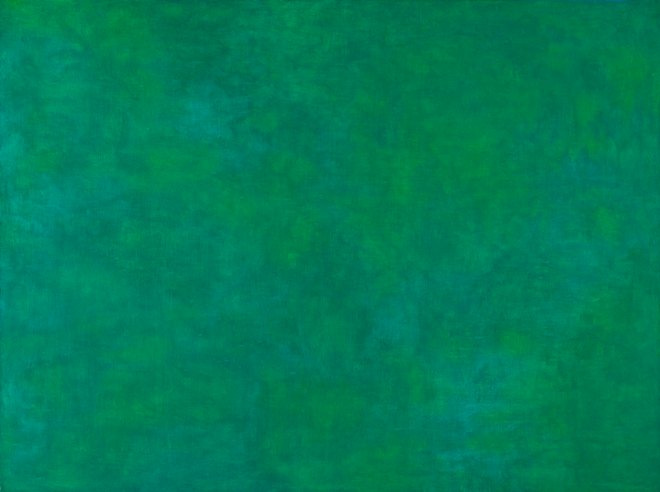
Claude Monet (French, 1840–1926), The Path under the Rose Arches, c. 1920–22. Oil on canvas, 36 1/4 x 35 in. (92 x 89 cm). Musée Marmottan Monet, Paris, 5104
(WILLIAMSTOWN, Mass.) – Monet | Kelly, the first exhibition to consider the influence of Impressionist painter Claude Monet on the works of leading contemporary American artist Ellsworth Kelly, opens at the Clark Art Institute on Sunday, November 23, 2014. The works in the exhibition were selected by Kelly and include two paintings and eighteen unpublished drawings by the artist, together with nine paintings by Monet from his Belle-Île series and of his garden in Giverny.
The exhibition examines how both Monet’s motifs and the sites that inspired his paintings have shaped Kelly’s approach to his work. Monet | Kelly will be on view through February 15, 2015.
In reference to a 1952 trip he took to see Monet’s home in the French village of Giverny, Kelly once wrote: “Monet’s last paintings had a great influence on me, and even though my work doesn’t look like his, I feel I want the spirit to be the same” (2001, Monet and Modernism, Prestel Publishing).
“Monet | Kelly is the result of Ellsworth Kelly’s extraordinary vision. It has been a marvelous opportunity for the Clark to work with Mr. Kelly and the exhibition will give audiences the opportunity to see these works through his perspectives as both curator and artist,” said Clark director Michael Conforti. “While many know Kelly for his reimagining of abstraction through bold color and graphic innovation, few are familiar with his direct engagement with Claude Monet’s work, first while he lived in postwar France, and then episodically over the decades that followed. This exhibition will shed new light on Monet’s continuing influence on Kelly.”

Ellsworth Kelly (American, b. 1923), Tableau Vert, 1952. Oil on wood, 29 1/4 x 39 1/4 in. (74.3 x 99.7 cm). The Art Institute of Chicago. Gift of the artist, 2009.51 © Ellsworth Kelly
Early in his career Kelly spent six formative years (1948–1954) in France, where he discovered the late work of Monet. His 1952 visit to Monet’s house and studio in Giverny inspired Kelly to create his first monochrome work, Tableau Vert (1952, Art Institute of Chicago), which is included in this exhibition. Of this visit, Kelly wrote: “There must have been fifteen enormous paintings, twenty feet long. I was very impressed. I had never seen paintings like this: overall compositions of thickly applied oil paint representing water with lilies, with no skyline. I felt that these works were beautiful, impersonal statements.”
Kelly made several subsequent visits to France, sometimes returning to Belle-Île, an island off the southern coast of Brittany where he had spent the summer of 1949. Significantly, Monet had made his own four-month sojourn on Belle-Île in 1886. During these journeys, he explored the motifs of artists who preceded him, including Monet, Paul Cézanne, and Henri Matisse. This exhibition examines a group of Kelly’s unpublished drawings made during these trips that emphasize geographical place in his response to earlier artists.
In selecting the Monet works included in the exhibition, Kelly sought out two distinct groups of paintings — those made on Belle-Île in 1886, and those depicting the gardens at Giverny made between 1900 and 1920. While the sites coincide with Kelly’s travels in France, there is no explicit link within Monet’s output between these two groups of works. Considering them together, however, helps to draw out the developments that occurred in Monet’s painting between 1886 and the later period.
Monet | Kelly marks the first public display of Kelly’s White Curve Relief over White (Belle-Île) of 2013, a painting which echoes his Belle-Île drawings. The exhibition also contains several important works by Monet on loan from public and private collections including Water Lilies, Study (1907, Musée Marmottan Monet, Paris), The Path under the Rose Arches (c. 1920–22, Musée Marmottan Monet, Paris), and The Japanese Bridge (c. 1923–25, Minneapolis Institute of Arts).
The exhibition is accompanied by an illustrated catalogue containing essays by noted scholars Yve-Alain Bois and Sarah Lees that explore the significance of Kelly’s 1952 visit to Monet’s studio to Kelly’s work, as well as the influence of the later Monet paintings on Kelly’s practice.
Monet | Kelly is organized by the Clark Art Institute. The exhibition is made possible by the generous contribution of Denise Littlefield Sobel. Additional support is provided by Agnes Gund and Emily Rauh Pulitzer.
About the Clark
The Clark Art Institute is one of a small number of institutions globally that is both an art museum and a center for research, critical discussion, and higher education in the visual arts. Opened in 1955, the Clark houses exceptional European and American paintings and sculpture, extensive collections of master prints and drawings, English silver, and early photography. Acting as convener through its Research and Academic Program, the Clark gathers an international community of scholars to participate in a lively program of conferences, colloquia, and workshops on topics of vital importance to the visual arts. The Clark library, open to the public with more than 240,000 volumes, is one of the nation’s premier art history libraries. The Clark also houses and co-sponsors the Williams College Graduate Program in the History of Art.
The Clark opened its expanded facilities on July 4, 2014, unveiling new and enhanced spaces that accommodate the continued growth of the Institute’s programs. Included in this final stage of the project are the new 42,600-square-foot Clark Center designed by Tadao Ando Architect & Associates, expansion and renovation of the original Museum Building and the ongoing renovation of the Manton Research Center by Selldorf Architects, and a sweeping redesign of the grounds by Reed Hilderbrand Landscape Architecture. The first phase of the campus expansion project was completed in 2008 with the opening of the Lunder Center at Stone Hill, a striking conservation and exhibitions facility also designed by Tadao Ando.
The Clark is located at 225 South Street in Williamstown, Massachusetts. Galleries are open Tuesday through Sunday, 10 am to 5 pm. Admission is $20 through October 31, 2014 and free year-round for Clark members, children 18 and younger, and students with valid ID. For more information, visit the Clark Art Institute or call 413 458 2303.
